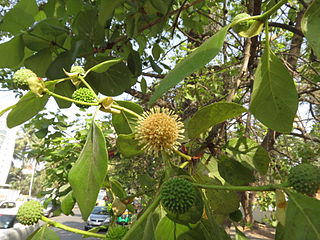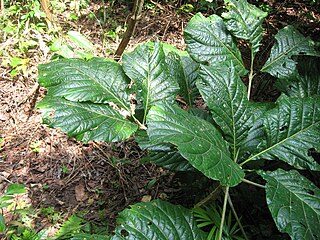
Rubiaceae is a family of flowering plants, commonly known as the coffee, madder, or bedstraw family. It consists of terrestrial trees, shrubs, lianas, or herbs that are recognizable by simple, opposite leaves with interpetiolar stipules and sympetalous actinomorphic flowers. The family contains about 14,100 species in about 580 genera, which makes it the fourth-largest angiosperm family. Rubiaceae has a cosmopolitan distribution; however, the largest species diversity is concentrated in the tropics and subtropics. Economically important genera include Coffea, the source of coffee; Cinchona, the source of the antimalarial alkaloid quinine; ornamental cultivars ; and historically some dye plants.

Melatonin, an indoleamine, is a natural compound produced by various organisms, including bacteria and eukaryotes. Its discovery in 1958 by Aaron B. Lerner and colleagues stemmed from the isolation of a substance from the pineal gland of cows that could induce skin lightening in common frogs. This compound was later identified as a hormone secreted in the brain during the night, playing a crucial role in regulating the sleep-wake cycle, also known as the circadian rhythm, in vertebrates.

Allicin is an organosulfur compound obtained from garlic and leeks. When fresh garlic is chopped or crushed, the enzyme alliinase converts alliin into allicin, which is responsible for the aroma of fresh garlic. Allicin is unstable and quickly changes into a series of other sulfur-containing compounds such as diallyl disulfide. Allicin is an antifeedant, i.e. the defense mechanism against attacks by pests on the garlic plant.

Mitragyna speciosa is a tropical evergreen tree of the Rubiaceae family native to Southeast Asia. It is indigenous to Cambodia, Thailand, Indonesia, Malaysia, Myanmar, and Papua New Guinea, where its leaves, known as "kratom" have been used in herbal medicine since at least the 19th century. They have also historically been consumed via chewing, smoking, and as a tea. Kratom has opioid-like properties and some stimulant-like effects. As of 2018, the efficacy and safety of kratom are unclear. In 2019, the United States Food and Drug Administration (FDA) stated that there is no evidence that kratom is safe or effective for treating any condition. Some people take it for managing chronic pain, for treating opioid withdrawal symptoms, or for recreational purposes. The onset of effects typically begins within five to ten minutes and lasts for two to five hours.

Vinca is an Old World genus of flowering plants in the family Apocynaceae, The English name periwinkle is shared with the related genus Catharanthus. Some Vinca species are cultivated but have also spread invasively. Additionally, some species have medicinal uses.The most spread species is Vinca minor.

Mitragyna parvifolia is a tree species found in Asia, native to India and Sri Lanka. Mitragyna species are used medicinally and for their fine timber throughout the areas where they grow. M. parvifolia reaches heights of 50 feet with a branch spread over 15 feet. The stem is erect and branching. Flowers are yellow and grow in ball-shaped clusters. Leaves are a dark green in color, smooth, rounded in shape, and opposite in growth pattern.

Carpaine is one of the major alkaloid components of papaya leaves which has been studied for its cardiovascular effects. Carpaine extracted from Carica papaya trees has been reported to have diverse biological properties, such as anti-malarial, anti-inflammatory, anti-oxidant, and vasodilatory effects. Especially, Carpaine possessed significant anti-plasmodial activity in vitro (IC50 of 0.2 μM) and high selectivity towards the parasites.

Mitragyna stipulosa is a species of flowering plant in the family Rubiaceae. It is found in Angola, Cameroon, Central African Republic, the Republic of the Congo, the Democratic Republic of the Congo, Gabon, Gambia, Ghana, Guinea, Nigeria, Senegal, Sierra Leone, Sudan, Uganda, and Zambia. Its natural habitats are subtropical or tropical moist lowland forests and subtropical or tropical swamps. It is threatened by habitat loss.

Schumanniophyton problematicum is a species of plant in the family Rubiaceae. It is found in Ivory Coast, Ghana, and Sierra Leone. It is threatened by habitat loss.

Pukateine is an alkaloid found in the bark of the New Zealand tree Laurelia novae-zelandiae ("Pukatea"), as well as some South American plants. An extract from pukatea is used in traditional Māori herbal medicine as an analgesic.

Rhynchophylline is an alkaloid found in certain Uncaria species (Rubiaceae), notably Uncaria rhynchophylla and Uncaria tomentosa. It also occurs in the leaves of Mitragyna speciosa (kratom) and Mitragyna tubulosa, a tree native to Thailand. Chemically, it is related to the alkaloid mitragynine.
Mitragyna rubrostipulata is a tree indigenous to East Africa. It is native from Ethiopia through east-central tropical Africa to Mozambique. It grows in wet forests up to 2,000 m above sea level and is abundant in swamp forests along Lake Victoria.

Naucleeae is a tribe of flowering plants in the family Rubiaceae and contains about 183 species in 24 genera. Species belonging to Naucleeae occur from Australasia, tropical Asia, Madagascar, tropical Africa, and to the Neotropics and North America.

Mitragynine pseudoindoxyl is a rearrangement product of 7-hydroxymitragynine, an active metabolite of mitragynine.

Mitragyna tubulosa is a tree species found in Peninsular India in the Western Ghats.

Persicaria minor is species of herb in the family Polygonaceae. Common names include pygmy smartweed, small water pepper and swamp willow weed. This herb is native to Asia, but distributed widely in Europe and Australia. It is used in South East Asian cooking.

Mitragynine is an indole-based alkaloid and is one of the main psychoactive constituents in the Southeast Asian plant Mitragyna speciosa, commonly known as kratom. It is an opioid that is typically consumed as a part of kratom for its pain-relieving and euphoric effects. It has also been researched for its use to potentially manage symptoms of opioid withdrawal.
Mitragyna ciliata is a species of flowering plant, a tree in the Gardenia Family (Rubiaceae), native to the rainforests of west and west-central tropical Africa. It was first described in 1936. It root structure is curious; the roots leave the ground in a smooth arc, then re-enter to make a subsurface arc, which is then repeated several times, and remindful of porpoises swimming at the sea's surface.

Casearia tomentosa, commonly known as the toothed leaf chilla, is a species of flowering plant in the family Salicaceae, native to the Indian Subcontinent and Myanmar. It is one of 1,000 species that can be found in the Salicaeceae family.

Speciociliatine is a major alkaloid of the plant Mitragyna speciosa, commonly known as kratom. It is a stereoisomer of Mitragynine and constitutes 0.00156 - 2.9% of the dried leaf material.



















